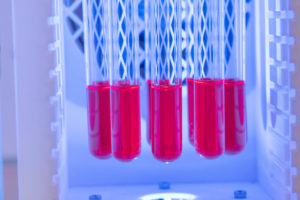Using sunlight as a source for climate-friendly energy supply: Long before major initiatives such as the European “Green Deal” or the “national hydrogen strategy”, the Transregio Collaborative Research Centre (SFB) CataLight started developing chemical solar energy converters. The consortium’s most important model from the universities of Ulm and Jena is natural photosynthesis. After four successful years on the path to decentralised production of green hydrogen, it has now been decided to continue funding the Transregio-SFB. The German Research Foundation (DFG) will fund the SFB/Transregio 234 “Light-driven molecular catalysts in hierarchically structured materials – synthesis and mechanistic studies” with more than 12 million euros until 2026.
Great success for the universities of Jena and Ulm: Over the next four years, interdisciplinary researchers in the Transregio SFB CataLight will continue to advance light-driven water splitting. One key is the optimisation of catalytic materials and methods. Previous systems for converting sunlight into chemical energy were relatively unstable: by embedding the light-driven catalyst molecules in soft matter, the consortium of chemistry, physics and material sciences succeeded in stabilising and controlling this process during the first funding phase.
The main goal of the Collaborative Research Centre, which has now been extended, is to lay the foundations for the efficient production of CO2-neutral hydrogen on a decentralised basis. The possible applications are diverse and range from mobile, solar-powered hydrogen filling stations to climate-friendly electricity and heat supply for residential buildings.
In the first funding phase, the SFB researchers took important steps towards the environmentally friendly production of solar fuels. “The research groups at the Universities of Ulm and Jena complement each other perfectly. Together we have developed, tested and linked molecular building blocks for solar energy conversion. In the process, we were able to gain fundamental insights into the structure of light-driven catalysts to carry out highly efficient energy conversion,” explains SFB spokesperson Professor Sven Rau, head of the Institute for Inorganic Chemistry I at the University of Ulm.
Concrete achievements of the first funding period range from the development of a compact single-molecule catalyst that can produce solar fuel in the dark thanks to light energy storage to a molecular repair mechanism for photocatalysts. Following natural photosynthesis, light-driven hydrogen formation can occur many times with the same molecule, making the system much more durable. In the DFG review, the CataLight school project was also singled out for particular praise: the researchers have designed teaching materials on the subject of artificial photosynthesis and made them available for chemistry lessons in grammar schools.
In the second funding phase starting in July 2022, the solar energy converters are to be made more sustainable: Currently, rare materials such as ruthenium, platinum or rhodium are still found in the catalysts or photo centres. These ecologically questionable components are to be replaced by more readily available alternatives. Organic dyes, such as those being researched in Jena, could solve the problem. Their instability can possibly be brought under control by the repair mechanisms developed in the SFB. “In addition, we will optimise the material linkage in solar energy converters in the second funding phase. The goal is a light-driven process with coupled oxidation and reduction. In addition, there will be the further development of physicochemical analysis methods,” explains Professor Benjamin Dietzek-Ivanšić from the University of Jena, who will be the spokesperson in the second funding phase. The long-term goal of the Transregional Collaborative Research Centre is: the production of artificial chloroplasts modelled on nature. These plant cell components are responsible for photosynthesis.
New partnerships strengthen the Transregional SFB CataLight
In addition to the lead universities of Jena and Ulm, the University of Vienna as well as the Max Planck Institute for Polymer Research in Mainz and the Leibniz Institute for Photonic Technologies e.V. contribute to the Collaborative Research Centre. In the future, the consortium will be expanded to include other strong partners: cooperation with the Centre for Solar Energy and Hydrogen Research (ZSW) in Ulm, Germany, is planned. SFB member Professor Carsten Streb has moved to the University of Mainz and will continue his research work for CataLight from there. In addition, researchers from the USA will join the SFB as Mercator Fellows. In addition, the SFB is a founding member of the CataLysis network, which brings together DFG-funded research initiatives around catalysis.
This preliminary work and new partnerships pave the way for a successful second funding phase and make a scientific contribution to tackling the energy transition.

